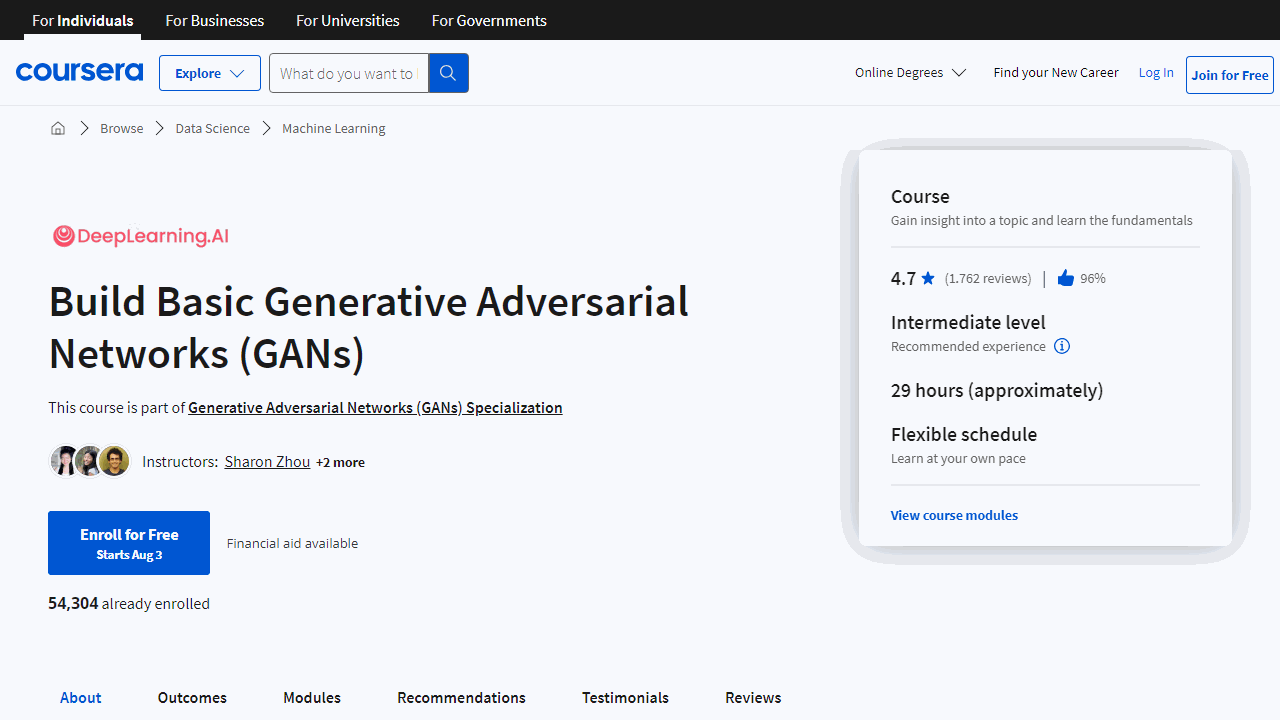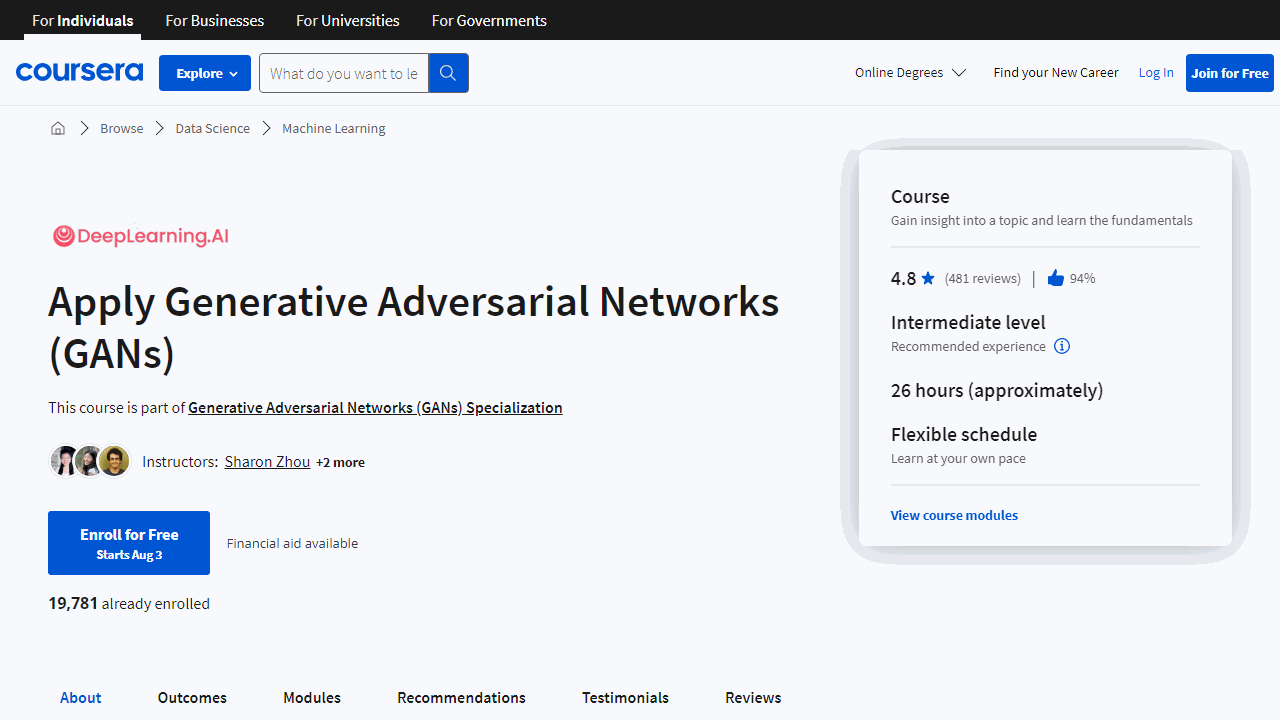- Rating: 4.7/5 with 1.974 ratings
- Provider: DeepLearning.AI
- Teacher: Sharon Zhou, Eda Zhou, Eric Zelikman
- Price: $49/month with a 7-day free trial
- Duration: Approx. 2 months if you study 10 hours per week (80 hours total)
- Pre-requisites: basic calculus, linear algebra, and stats, basic knowledge of deep learning and CNNs, intermediate Python skills, experience with Tensorflow, Keras or PyTorch
- Certificate: Yes
- Coursera Plus: No
Deep Learning is an exciting field that is rapidly advancing and gaining popularity.
One cutting-edge technology within this field is Generative Adversarial Networks (GANs).
However, it can be challenging to find high-quality, comprehensive courses that can help you master this technology.
Don’t worry, though; there’s a solution.
The online platform Coursera offers a series of courses in a specialization called “Generative Adversarial Networks (GANs)”.
These courses, provided by DeepLearning.AI, are designed to help you understand the concepts and purposes of GANs, learn about their components, and apply your knowledge to real-life applications.
As a bonus, you can try the courses for free for seven days.
With persistence and dedication, you’ll level up your skills and potentially open up a world of new career opportunities. So, why not give it a shot?
Build Basic Generative Adversarial Networks (GANs)
- Rating: 4.7/5 with 1.762 ratings
- Duration: Approx. 26 hours
This course is an excellent introduction to the world of GANs.
It’s designed to provide a basic overview of the current trends and applications of GANs, with a focus on image generation applications.
The course is structured systematically, making it suitable for learners who prefer organized content.
The course content is divided into four weeks, each focusing on a different aspect of GANs.
The first week provides an introduction to generative models and GANs, while the second week delves into activation functions and batch normalization.
The third week discusses the challenges with BCE loss and introduces the concept of Wasserstein loss.
The final week explores the concept of conditional generation and disentanglement.
The course is taught by Sharon Zhou, who has received praise for her clear and deep explanations.
However, some students have suggested that she could improve her teaching by speaking at a slower pace and using more pen interaction with the slides.
One of the unique aspects of this course is the practical application of the concepts taught.
The assignments are designed to provide hands-on experience with GANs, with a focus on understanding the science behind the codes.
Some students have found the assignments to be too cryptic, suggesting that they could benefit from more detailed explanations and more challenging coding tasks.
Despite these criticisms, many students have found the course to be highly informative and enjoyable.
They have praised the course for its clear lectures, insightful theory, and practical examples.
Some have even described it as the best course on GANs available.
If you’re interested in learning about GANs and want a course that combines theory with practical application, the “Build Basic Generative Adversarial Networks (GANs)” course could be a great choice for you.
However, be prepared to supplement your learning with additional resources.
What You Will Learn
- Understand the concept and purpose of Generative Adversarial Networks (GANs) and their real-life applications.
- Learn about the two main components of GANs: the Discriminator and the Generator.
- Grasp the Binary Cross Entropy (BCE) Cost Function and its role in training GANs.
- Get introduced to PyTorch, a popular open-source machine learning library.
- Explore various activation functions and their properties, and understand the concept of Batch Normalization.
- Learn about Convolutions, Padding, Stride, Pooling, and Upsampling in the context of GANs.
- Understand the problem of Mode Collapse in GANs and learn about alternative loss functions like Earth Mover’s Distance and Wasserstein Loss.
- Learn about the concept of 1-Lipschitz Continuity Enforcement in GANs.
- Understand the concept of Conditional Generation and how it can be used to control the output of GANs.
- Learn about Vector Algebra in the Z-Space, the challenges with Controllable Generation, Classifier Gradients, and Disentanglement in GANs.
Build Better Generative Adversarial Networks (GANs)
- Rating: 4.7/5 with 597 ratings
- Duration: Approx. 24 hours
This course is packed with a wealth of information and resources to, like the name says, help you take the next step after the first course and build better GANs.
You’ll be working with PyTorch, a popular deep learning framework, and you’ll get hands-on experience with programming and debugging.
The course is structured into three weeks.
In the first week, you’ll delve into the evaluation of GANs, learning about concepts like Fréchet Inception Distance (FID) and Inception Score.
You’ll also explore sampling and truncation, as well as precision and recall.
These are crucial concepts in machine learning and will be invaluable in your journey to mastering GANs.
In the second week, you’ll tackle the disadvantages of GANs and explore alternatives.
This week also introduces the topic of machine bias and fairness, which is a unique and important aspect of AI that’s often overlooked in similar courses but has grown in importance in recent years.
The third week is where things get really exciting.
You’ll dive into GAN improvements and get an in-depth look at StyleGAN, a state-of-the-art GAN architecture.
You’ll learn about progressive growing, noise mapping network, and Adaptive Instance Normalization (AdaIN).
This week will also cover style and stochastic variation, and you’ll get to put everything you’ve learned together.
The pace of the course can be fast, so be prepared to pause and rewind as needed.
The course also includes a number of programming assignments.
These assignments are designed to give you practical experience with the concepts you’re learning.
Some students have noted that they would have preferred more detailed guidance and less pre-written code in these assignments.
Despite these minor drawbacks, the course has been well-received overall.
Many students have praised the course for its comprehensive content, clear explanations, and practical assignments.
What You Will Learn
- Understand the evaluation methods for Generative Adversarial Networks (GANs) including comparing images and feature extraction.
- Learn about Inception-v3 and embeddings, and how they are used in GANs.
- Gain knowledge on Fréchet Inception Distance (FID) and Inception Score, two important metrics for assessing the quality of GANs.
- Explore the concepts of sampling and truncation in the context of GANs.
- Delve into the precision and recall metrics, and their relevance in GANs.
- Discuss the disadvantages of GANs and explore potential alternatives.
- Understand the concept of machine bias, how to define fairness, and ways bias can be introduced in GANs.
- Learn about the improvements that can be made to GANs to enhance their performance.
- Get an overview of StyleGAN, a state-of-the-art GAN model, and understand its components like progressive growing, noise mapping network, and Adaptive Instance Normalization (AdaIN).
- Understand the concepts of style and stochastic variation in GANs, and how to put all the learned concepts together to build better GANs.
Apply Generative Adversarial Networks (GANs)
- Rating: 4.8/5 with 481 ratings
- Duration: Approx. 26 hours
This is a comprehensive course that covers a wide range of topics, from data augmentation to privacy and image-to-image translation.
The course is well-structured and the content is up-to-date with the state of the art in GANs.
The programming assignments are meticulously crafted to help you solidify the concepts taught during the week.
If you’re planning to start your own GAN project, these assignments will provide you with transparent and reusable pieces of code to get you started.
The course also provides a great balance between theory and practice.
You’ll get to learn about the latest advancements in GANs, such as Pix2Pix and CycleGAN, and then apply what you’ve learned in practical assignments.
It’s worth noting that some students found the course challenging, particularly when it came to the programming assignments.
If you’re not familiar with PyTorch, you might find these assignments a bit difficult.
But don’t let that deter you. The course provides plenty of resources to help you along the way.
Overall, the student feedback is overwhelmingly positive.
Many students praised the course for its high-quality content, well-designed assignments, and engaging teaching style.
What You Will Learn
- Review the fundamental concepts and applications of Generative Adversarial Networks (GANs)
- Explore the role of GANs in data augmentation, including its methods, uses, advantages, and disadvantages
- Learn about the use of GANs in maintaining privacy and anonymity in data
- Dive into the specifics of image-to-image translation using GANs
- Gain a comprehensive understanding of Pix2Pix, PatchGAN, U-Net, Pixel Distance Loss Term, and how to put it all together
- Stay updated with the latest advancements in Pix2Pix
- Discover the concept of unpaired image-to-image translation
- Get a detailed overview of CycleGAN, including its two GANs, cycle consistency, least squares loss, identity loss, and how to put it all together
- Understand the practical applications and variants of CycleGAN
Frequently Asked Questions
How Long Does It Take To Complete The Generative Adversarial Networks Specialization?
It’s estimated to take approximately 2 months to complete if you study around 10 hours per week.
This means the total duration of the specialization is roughly 80 hours.
However, the actual time it takes can vary depending on your prior knowledge, learning pace, and the amount of time you can dedicate to the courses each week.
How Much Does The Generative Adversarial Networks Specialization Cost?
The Generative Adversarial Networks Specialization on Coursera costs $49 per month.
This fee gives you access to all the course materials, graded assignments, and a certificate upon completion.
The specialization also offers a 7-day free trial, allowing you to explore the course content before committing to the monthly fee.
Please note that prices may vary depending on your location and any promotions Coursera may be running at the time.
Is The Generative Adversarial Networks Specialization Part Of Coursera Plus?
No. Coursera Plus subscribers do not have access to the Generative Adversarial Networks Specialization.
What Is The Difference Between A Coursera Course And A Specialization?
A Coursera course is a single, standalone module that focuses on a specific topic. It includes video lectures, readings, quizzes, and sometimes a final project or exam.
Once you complete a course, you receive a certificate of completion.
On the other hand, a Coursera Specialization is a series of related courses designed to help you master a specific topic.
Specializations are structured to provide a deeper, more comprehensive understanding of a subject area.
They often culminate in a capstone project that allows you to apply what you’ve learned throughout the courses.
Once you complete all the courses in a Specialization, you receive a Specialization certificate.
So, the main difference is that a course is a single module on a specific topic, while a Specialization is a series of related courses designed to provide a comprehensive understanding of a broader subject area.
How To Get The Generative Adversarial Networks Specialization For Free?
Coursera offers financial aid for students who cannot afford the fee.
You can apply for financial aid by clicking on the “Financial aid available” link next to the “Enroll” button on the course page.
You’ll need to fill out an application and wait for approval, which can take up to 15 days.
Also, Coursera occasionally offers promotions or discounts, so it’s worth checking their website regularly.
Please note that while you may be able to access some course materials for free during a trial period, you typically need to pay for the course to receive a certificate.



